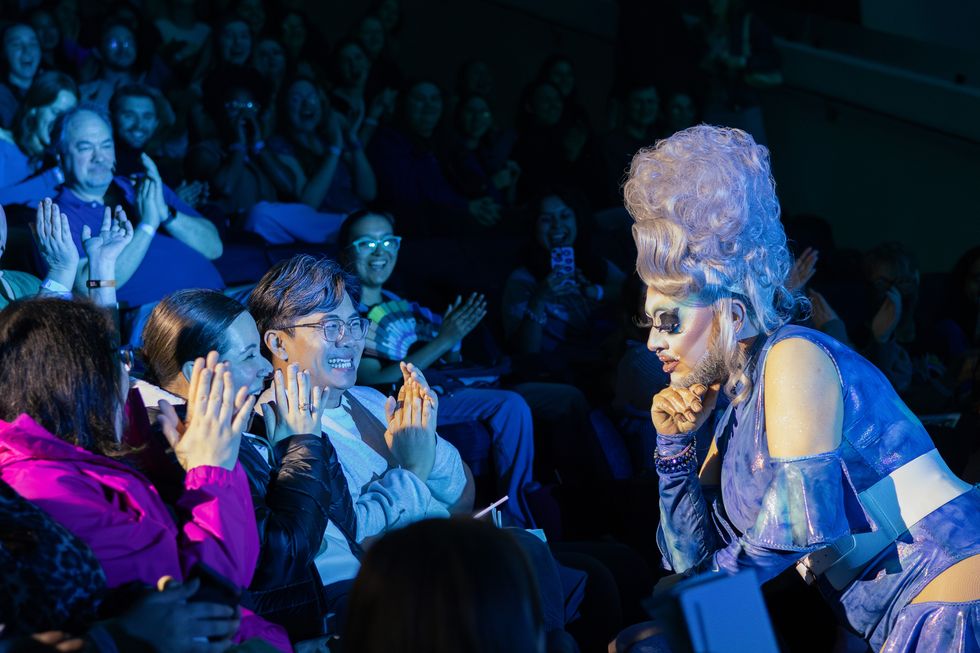Once inside Chicago’s Adler Planetarium, summer museumgoers stroll down a backlit hallway that shifts between dreamy blues and purples while projected stars spiral across the carpeted floor. These splashes of light represent the gigantic first-generation stars that lived brightly, albeit briefly, before exploding into supernovas that spewed out the minerals and metals we use today—the calcium in our bodies, the gold on our wristwatches. Astrophysicist Lucianne Walkowicz, our cosmic guide for the day, is excitedly explaining this as a star swirls beneath her feet. After a moment, the projection explodes across the floor in a brilliant, colorful burst.
This is just one of the interactive digital elements woven throughout the planetarium in an effort to make the dark expanses of cosmology more tangible. Luckily for the inquisitive sort, Walkowicz is keen to share her passion for these celestial bodies. She studies how stars affect a planet’s habitability—whether the high-energy radiation beaming off a given star might allow its particular spinning planets to sustain life. Besides being a resident astronomer at Adler, Walkowicz, 36, is a former NASA Kepler Fellow for the study of planet-bearing stars at UC Berkeley and a current leader in the Large Synoptic Survey Telescope (LSST) mission, which will photograph the visible sky every few nights from a Chilean mountaintop, capturing, as LSST describes it, “the greatest movie ever made... the first motion picture of our universe.”
Beneath Adler, Walkowicz’s windowless office is almost devoid of the cosmic grandeur above, though that doesn’t temper her enthusiasm. “We think of space being this really abstract, out-there thing, but it’s governed by rules that we’re familiar with—like what happens when you pour cream in your coffee,” she says. In particular, Walkowicz is interested in turning scientific data into art—for example, transforming the frequencies of spinning stars into music—so that her audience can encounter scientific information in a more fluid, unsolved form, rather than via “an explanatory plaque at a museum.” She hopes her art will push people to the most ancient of human experiences: wonder.
“You can walk through a park and encounter a piece of art without expecting it,” she says, “but there’s nothing like that in science.” To counter this, she spearheaded Science Train, a guerrilla astronomy project, which stuck scientists on public transit to answer questions everyday commuters might have. Last year, they invaded New York City subways without notifying authorities—happily, nobody complained—and are headed to Chicago next. “We’re not proselytizing science, we’re just putting ourselves where people are,” she says.
Still, Walkowicz is eager to share her knowledge through whatever means available. “Science is a very human undertaking, and I see astronomy as a very human experience. Wondering, for example, ‘Is there life in the universe?’ is a very human question,” she says, lamenting that those who don’t pursue science professionally often feel excluded from the magic of the cosmos.
“I feel very compelled to use astronomy as a platform to empower people, and particularly to empower a wider variety of people than have traditionally partaken in science or thought of themselves as scientists,” she says. “If you have a diverse environment, that means that you have a representative sample of humanity asking questions about the world around them.”
















 Let us all bow before Gary, the Internet's most adventurous feline. Photo credit: James Eastham
Let us all bow before Gary, the Internet's most adventurous feline. Photo credit: James Eastham Gary the Cat enjoys some paddling. Photo credit: James Eastham
Gary the Cat enjoys some paddling. Photo credit: James Eastham James and Gary chat with Ryan Reed and Tony Photo credit: Ryan Reed
James and Gary chat with Ryan Reed and Tony Photo credit: Ryan Reed

 Rock deterioration has damaged some of the inscriptions, but they remain visible. Renan Rodrigues Chandu and Pedro Arcanjo José Feitosa, and the Casa Grande boys
Rock deterioration has damaged some of the inscriptions, but they remain visible. Renan Rodrigues Chandu and Pedro Arcanjo José Feitosa, and the Casa Grande boys The Serrote do Letreiro site continues to provide rich insights into ancient life.
The Serrote do Letreiro site continues to provide rich insights into ancient life.

 The contestants and hosts of Draggieland 2025Faith Cooper
The contestants and hosts of Draggieland 2025Faith Cooper Dulce Gabbana performs at Draggieland 2025.Faith Cooper
Dulce Gabbana performs at Draggieland 2025.Faith Cooper Melaka Mystika, guest host of Texas A&M's Draggieland, entertains the crowd
Faith Cooper
Melaka Mystika, guest host of Texas A&M's Draggieland, entertains the crowd
Faith Cooper


